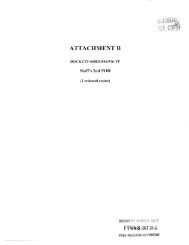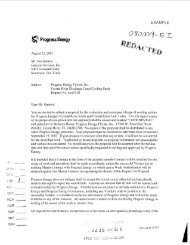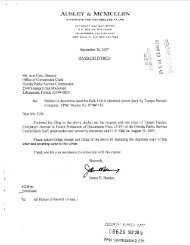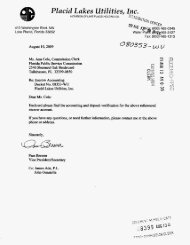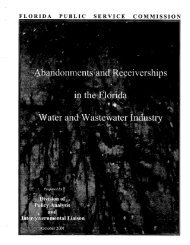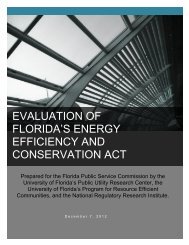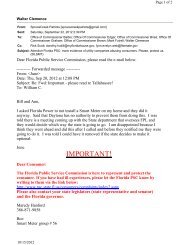Review of 2008 Ten-Year Site Plans - Public Service Commission
Review of 2008 Ten-Year Site Plans - Public Service Commission
Review of 2008 Ten-Year Site Plans - Public Service Commission
Create successful ePaper yourself
Turn your PDF publications into a flip-book with our unique Google optimized e-Paper software.
y the <strong>Commission</strong> represent a minimum threshold utilities must meet before building any major<br />
power plants.<br />
The seven Florida utilities which are subject to FEECA currently <strong>of</strong>fer more than 100 DSM<br />
and conservation programs to residential, commercial, and industrial customers in an effort to meet<br />
the objectives set forth by the FEECA. Energy audit programs provide a first step for utilities and<br />
customers to assess conservation opportunities for Florida’s electric customers and serve as the<br />
foundation for all other DSM and conservation programs. Each utility subject to FEECA is required<br />
to <strong>of</strong>fer energy audits to residential customers, pursuant to Section 366.82(5), F.S., and most utilities<br />
also provide energy audits for commercial/industrial customers.<br />
Load management and interruptible load programs also play a significant role in any utility<br />
energy conservation plan. Load management programs pay the participant for allowing the utility to<br />
control when certain electric appliances are available for use. Interruptible load programs allow a<br />
utility to interrupt specific services to a commercial or industrial customer. Load management and<br />
interruptible service are measures that allow reductions in system peak demand when needed.<br />
Load and energy savings from non-dispatchable DSM (conservation), such as ceiling<br />
insulation, are included in a utility’s demand and energy forecast. Such programs enable utilities and<br />
customers to realize sustained energy savings over time. Savings from dispatchable DSM, such as<br />
load management and interruptible service, are added separately. All DSM and conservation savings<br />
reduce the utilities’ projected peak demand.<br />
DSM programs are projected to reduce summer peak demand by just over 5,800 MW in <strong>2008</strong><br />
to more than 7,600 MW by 2017, while winter peak demand reductions are projected to exceed 7,800<br />
MW by 2017. Projections indicate a summer and winter peak demand reduction <strong>of</strong> approximately 12<br />
percent from DSM for each year between <strong>2008</strong> and 2017. Figure 5 below and Figure 6 on the<br />
following page illustrate the projected total amounts <strong>of</strong> summer peak demand and winter peak<br />
demand savings from utility-sponsored DSM programs over the ten-year planning horizon.<br />
Summer Demand Savings (MW)<br />
9000<br />
8000<br />
7000<br />
6000<br />
5000<br />
4000<br />
3000<br />
2000<br />
1000<br />
0<br />
Figure 5. State <strong>of</strong> Florida: DSM Summer Peak Demand Savings<br />
<strong>2008</strong> 2011 2014 2017<br />
Conservation Interruptible Load Load Management<br />
<strong>Review</strong> <strong>of</strong> <strong>2008</strong> <strong>Ten</strong>-<strong>Year</strong> <strong>Site</strong> <strong>Plans</strong> - 12 -



